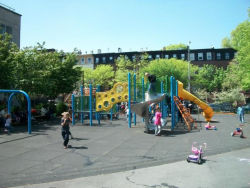James Forten Playground
James Forten Playground
What was here before?
This property was once the site of the pumping station for the Mount Prospect Reservoir built in 1856. When the New York City water supply expanded to include the Catskills and Delaware watersheds to accommodate the growing population, this reservoir was no longer necessary by the 1930s and was torn down in 1935.
How did this site become a playground?
NYC Parks was assigned this property in 1940. It was named Underhill Playground in 1985 after the nearby avenue and 17th century settler and solider, Captain John Underhill (1597-1672). Underhill is known for his graphic account of the Pequot Massacre, Newes from America, where he describes the killing of the majority of the tribe and enslavement of the surviving tribesmen. The park was renamed in 2021 due to its namesakes’ participation.
In 1996, new safety surfacing and wrought iron fences featuring duck animal art were installed. In 2007, Julie Peppito’s artwork was integrated with the playground and includes mosaic tiles, sculptures, and concrete motifs. The playground has many grassy areas and trees surrounding the play area.
Who is this playground named for?
In 2021, as part of the second phase of NYC Parks’ initiative to expand the representation of African Americans honored in parks, this playground was renamed for prominent abolitionist, businessman, and vice president of the Anti-Slavery Society, James Forten (1766-1842).
Forten was born in Philadelphia, Pennsylvania to free Black parents in 1766 and educated in an African Quaker School. At the age of eight, he began working with his father who was a sailmaker and journeyman at the Robert Bridges’ sail loft. When his father died the following year, Forten had to work full time at a grocer to help support his family.
In July 1781, he boarded the Royal Louis, an armed commercial ship supported by the Continental Army, and served as a powder-boy responsible for transporting gunpowder from the hold to the guns. The ship was captured by the British, and the crew was taken to the infamous prison ship, The Jersey which was anchored in nearby Wallabout Bay in Brooklyn. He was freed during a prisoner exchange in 1782 and returned to Philadelphia on foot.
Forten went back to Robert Bridges’ sail loft to apprentice as a sailmaker. By 1801, he bought the business, which became extremely profitable. He used his amassed wealth to help fellow African Americans by funding the abolitionist newspaper The Liberator, participating in the Underground railroad, and funding schools.
Forten was a founding member of the Free African Society and the vice president of the Anti-Slavery Society. He was against the American Colonization Society, which supported the international resettlement of Black people. He was vocal in his opposition to slavery and advocated for the civil rights of Black people. Forten died in 1842. His children and grandchildren were abolitionists and suffragists and continued his legacy of civil rights.
Check out your park's Vital Signs
Clean & Safe
Green & Resilient
Empowered & Engaged Users
Share your feedback or learn more about how this park is part of a
Vital Park System




